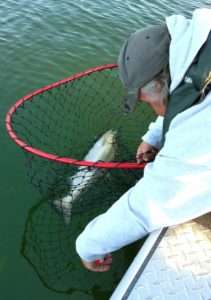
Biologist Bemoans Delays Approving Clackamas Wild Spring Chinook Hatchery Broodstock Plan
Editor’s note: This story originally appeared August 6, 2021, as a Facebook exclusive.
“Opportunity to collect fish is lost with every passing day.”
So says Oregon’s spring Chinook fisheries biologist for the Clackamas.

Ben Walczak has been ready for weeks to start collecting wild adults at an upstream fish trap on the Portland-area river as part of ODFW’s and local springer anglers’ bid to replace the failing out-of-basin hatchery run with one based on the local stock.
But first they have to get approval from the National Marine Fisheries Service to do so.
Their hatchery and genetic management plan, or HGMP, was submitted back in May 2020. On late Wednesday afternoon a federal spokeswoman said the final go-ahead should come “within the next week.”
The long wait is a function of an Endangered Species Act listing on Willamette Basin springers, but it’s also cutting into the viability of ODFW’s goal to collect fish from across the Clackamas run to better represent the stock. Biologists wanted to begin July 15.
“Selecting only later-returning fish likely does not accomplish this goal,” said Walczak. “To date, natural-origin spring Chinook passage at Portland General Electric’s North Fork Dam fish-counting facility is approximately two-thirds complete.”
That means chances to collect adult salmon and better replicate the run’s late winter-to-early fall timing this year are diminishing.
In a nutshell, ODFW’s plan is to jumpstart a new integrated hatchery broodstock on the Clack by collecting 120 wild springers annually for three years, releasing 1.2 million smolts in three locations on the system, and keeping the natural-origin run’s genetics as close to natural as possible by mixing in eggs and milt from 21 to 45 native females and males, depending on run size, in subsequent years.
The agency’s HGMP also shows biologists had wanted to get cracking on collections last summer, but given all the paperwork on NMFS’s desk and its perennially achingly slow pace – the Clackamas application includes reviewing for a triple canopy of federal protections – that was a bit of a moonshot.
Still, it all comes as PGE has spent some $90 million over the past 15 years on fish passage at its dams, along with performing habitat restoration and improvement throughout the basin. Last year just under 4,000 native springers returned, a “record (that) reflects decades of hard work from many stakeholders in the basin,” the utility said on its website.
The article on this that we posted here yesterday sparked a really good discussion about whether to even start a new hatchery program if the current wild run is doing so well and using a small part of it in a carefully controlled way that will allow for both continued wild fish recovery and a consumptive angling close to a major Northwest metropolitan area.
ODFW’s HGMP also aims to test state biologists’ “genetic rescue” hypothesis, that using wild spring Chinook for broodstock will increase smolt-to-adult returns of hatchery salmon.
The current Clackamas king program has fallen way off, from SARs that were once as high as 1.5 percent in the early 2000s, fueling annual 1,000-plus-fish catches, to .04 and .02 percent and a big fat goose egg for boat and bank anglers in the 2019 season.
NMFS’s late-arriving greenlight has other implications.
“There is a sweet spot every season where fish are ripe enough to spawn but still strong enough to survive collection prior to spawning,” ODFW’s Walczak said. “As September progresses that window closes.”
And based on genetic work, the odds of fall Chinook being present also rises the deeper into September it gets, he added.
NMFS spokeswoman Hannah Mellman said the agency didn’t have further statements on the situation.
Along with the Clackamas’s faltering hatchery-fish-based fishery and plummeting smolt-to-adult return rates under the current program, ODFW hasn’t been meeting broodstock needs either. Walczak believes that the collection target of 400 females will fall well short this year – but it’s a much closer call if he finally gets permission from NMFS to access wild springers.
“Right now we have 150 on hand and we’ve collected approximately 50 percent of the run by this time of year. What that means is if the trend is ‘normal,’ we should see another 150 females, putting us at a total of 300. Obviously not all of the fish collected will be spawned for various reasons, but if we added wild fish to that, it could mean the difference between falling short of program goals or meeting them. We’re logistically that close.”
The next few days should tell the tale of what happens next.
